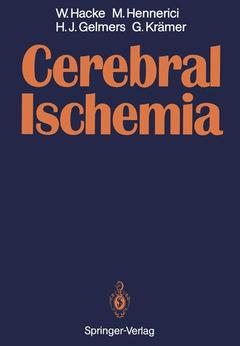Description
Cerebral Ischemia, Softcover reprint of the original 1st ed. 1991
Authors: Hacke Werner, Hennerici Michael, Gelmers Herman J., Krämer Günter
Language: French
Subjects for Cerebral Ischemia:
Approximative price 52.74 €
In Print (Delivery period: 15 days).
Add to cart
Publication date: 01-2012
238 p. · 17x24.2 cm · Paperback
238 p. · 17x24.2 cm · Paperback
Description
/li>Contents
/li>
Despite a worldwide reduction in its incidence, stroke remains one of the most common diseases generally and the most important cause of premature and persistent disability in the industrialized countries. The most frequent cause of stroke is a localized disturbance of cerebral circulation, i.e., cerebral ischemia. Less common are spon taneous intracerebral and subarachnoid hemorrhages and sinus ve nous thromboses. The introduction of new diagnostic procedures such as cranial computed tomography, magnetic resonance imaging, digi tal subtraction radiologic techniques, and various ultrasound tech niques has led to impressive advances in the diagnosis of stroke. Through the planned application of these techniques, it is even possible to identify the pathogenetic mechanisms underlying focal cerebral ischemia in humans. However, these diagnostic advances have made the gap between diagnostic accuracy and therapeutic implications even greater than before. This fact can be easily explained. In the past, therapeutic studies had to be based on the symptoms and temporal aspects of stroke; it was impossible for early investigations to consider the various pathogeneses of cerebral ischemia. Inevitably, stroke patients were treated as suffering from a uniform disease.
1 Applied Anatomy of the Cerebral Arteries.- 1.1 Extracranial Anatomy.- 1.2 Intracranial Anatomy.- 1.2.1 Carotid, Middle, and Anterior Cerebral Territory.- 1.2.2 Vertebrobasilar and Posterior Cerebral Territory.- 1.3 Collaterals and Anastomoses.- 1.4 Arterial Anatomy and Infarct Types.- References.- 2 Pathophysiology of Cerebral Ischemia.- 2.1 Introduction.- 2.2 General Aspects of Brain Cell Metabolism.- 2.2.1 Significance of Calcium.- 2.3 Regulation of Cerebral Circulation.- 2.3.1 Cerebral Perfusion Pressure and Vascular Resistance.- 2.3.2 Autoregulation.- 2.3.3 Functional Regulation.- 2.3.3.1 Blood Gas Influences.- 2.3.3.2 Ionic Influences.- 2.3.3.3 Other Possible Regulatory Principles.- 2.4 Cerebral Ischemia.- 2.4.1 Ischemic Thresholds and the Penumbra.- 2.4.2 The Course of an Ischemic Lesion.- 2.5 Ischemic Cerebral Edema.- References.- 3 Epidemiology and Classification of Strokes.- 3.1 Epidemiology.- 3.1.1 Definitions.- 3.1.2 Descriptive Epidemiology.- 3.1.2.1 Prevalence.- 3.1.2.2 Mortality and Incidence.- 3.1.3 Risk Factors.- 3.1.4 Course and Prognosis.- 3.1.4.1 Asymptomatic Extracranial Vascular Processes.- 3.2 Definitions and Classification of Strokes.- 3.2.1 Ischemia or Hemorrhage?.- 3.2.2 Classification of Ischemia.- 3.2.2.1 Classification by Temporal Course.- 3.2.2.2 Classification by Vascular Territories.- 3.2.2.3 Further Approaches to Classification.- 3.2.3 A Suggested Pathogenetic Classification of Infarcts Based on CT and Angiographic Findings.- References.- 4 Clinical Syndromes, Pathogenesis, and Differential Diagnosis.- 4.1 Symptoms and Syndromes—Temporal and Topical Aspects.- 4.1.1 Carotid Artery Territory.- 4.1.1.1 Carotid Artery.- 4.1.1.2 Branches from the Carotid Siphon.- 4.1.1.3 Middle Cerebral Artery.- 4.1.1.4 Anterior Cerebral Artery.- 4.1.1.5 Extraterritorial Zones.- 4.1.2 Vertebrobasilar Territory.- 4.1.2.1 Branches Adjacent to the Aortic Arch and Extracranial Vertebral Artery.- 4.1.2.2 Intracranial Vertebral Artery and Cerebellar Arteries.- 4.1.2.3 Basilar Artery and Branches.- 4.1.2.4 Penetrating End-Arteries.- 4.1.2.5 Posterior Cerebral Artery.- 4.2 Pathogenetic Aspects.- 4.2.1 Arteriosclerosis.- 4.2.2 Arterial Dissection.- 4.2.3 Fibromuscular Dysplasia.- 4.2.4 Arteritis.- 4.2.5 Dilational Arteriopathy.- 4.2.6 Nonarteriosclerotic Vasculopathies.- 4.2.7 Drugs and Alcohol.- 4.2.8 Other, Rare Causes.- 4.3 Special Types.- 4.3.1 Asymptomatic Vascular Processes.- 4.3.2 Multi-infarct Syndromes.- 4.3.2.1 Subcortical Arteriosclerotic Encephalopathy.- 4.3.2.2 Multi-infarct Dementia.- 4.3.2.3 Corresponding Bihemispheric Lesions.- 4.3.2.4 Secondary Hemorrhagic Transformation.- 4.4 Differential Diagnosis.- 4.5 Thrombosis of Cerebral Venous Sinuses.- References.- 5 Diagnosis.- 5.1 History and Clinical Findings.- 5.1.1 General Impressions and General Findings.- 5.1.2 Neurologic History and Examination Findings.- 5.1.3 Neuropsychological Symptoms.- 5.1.3.1 Aphasias.- 5.1.3.2 Apraxias.- 5.1.3.3 Anosognosia and Neglect.- 5.1.4 Vascular Diagnosis.- 5.1.5 Cardiologic Diagnosis.- 5.1.6 Laboratory Diagnosis.- 5.2 Ultrasound Diagnosis.- 5.2.1 Continuous and Pulsed Doppler Techniques.- 5.2.1.1 Indirect Methods.- 5.2.1.2 Direct Methods.- 5.2.2 B-Mode Ultrasound, Duplex System Analysis, and Color-Coded Doppler Flow Imaging.- 5.2.3 Transcranial Doppler Ultrasound.- 5.3 Computer-Assisted Imaging Techniques.- 5.3.1 Cranial Computed Tomography.- 5.3.1.1 Temporal Development of CT Findings.- 5.3.1.2 Macroangiopathies.- 5.3.1.3 Microangiopathies.- 5.3.1.4 CT Findings in the Vertebrobasilar Territory.- 5.3.1.5 Technical Limitations and Fogged Images.- 5.3.1.6 Secondary Hemorrhagic Infarcts.- 5.3.2 Magnetic Resonance Imaging.- 5.3.3 Other Imaging Techniques (PET, SPECT).- 5.4 Electrophysiologic Investigations.- 5.4.1 Electroencephalography.- 5.4.2 Evoked Potentials.- 5.4.2.1 Visual Evoked Potentials.- 5.4.2.2 Brainstem Auditory Evoked Potentials.- 5.4.2.3 Somatosensory Evoked Potentials.- 5.4.3 Topographic EEG Analysis (“Brain Mapping”).- 5.4.4 Transcranial Magnetic Stimulation.- 5.5 Cerebral Angiography.- 5.5.1 Indications for Angiography.- 5.5.2 Technique of Angiography.- 5.5.3 Illustrative Angiographic Findings.- 5.5.4 Interventional Neuroradiology.- 5.5.4.1 Percutaneous Transluminal Angioplasty.- 5.5.4.2 Local Fibrinolytic Therapy.- References.- 6 Treatment and Prophylaxis.- 6.1 General Treatment.- 6.1.1 Associated Systemic Diseases.- 6.1.2 Airways, Oxygenation, and Pulmonary Function.- 6.1.3 Heart.- 6.1.4 Hypertension.- 6.1.5 Diabetes Mellitus.- 6.1.6 Water and Electrolyte Balance.- 6.1.7 Other Measures.- 6.1.8 General Care.- 6.2 Special Treatment in the Acute Phase.- 6.2.1 Preliminary Remarks on the Treatment of Ischemic Cerebral Infarcts.- 6.2.2 Drugs to Improve Perfusion of Ischemic Brain Tissue.- 6.2.2.1 Measures to Improve the Rheologie Properties of the Blood.- 6.2.2.2 Vasopressor Drugs.- 6.2.2.3 Vasodilators.- 6.2.2.4 Aminophylline.- 6.2.2.5 Prostacyclin.- 6.2.3 Drugs to Affect the Blood Clotting Mechanism.- 6.2.3.1 Anticoagulants.- 6.2.3.2 Thrombolytics.- 6.2.4 Drugs to Protect Ischemic Brain Tissue.- 6.2.4.1 Barbiturates.- 6.2.4.2 Calcium Antagonists.- 6.2.4.3 Other Therapeutic Approaches.- 6.2.5 Drug Treatment of Ischemic Cerebral Edema.- 6.2.5.1 Corticoids.- 6.2.5.2 Hyperosmolar Substances.- 6.2.6 Treatment of Inflammatory Cerebral Vascular Processes.- 6.2.6.1 Treatment of Immunovasculitis.- 6.2.6.2 Treatment of Specific Infective Vasculitis.- 6.3 Prophylaxis of Cerebral Ischemia.- 6.3.1 Drug Prophylaxis.- 6.3.1.1 Platelet-Aggregation Inhibitors.- 6.3.1.2 Anticoagulants.- 6.3.2 Prophylactic Surgical Therapy.- 6.3.2.1 Carotid Endarterectomy.- 6.3.2.2 EC-IC Bypass Operation.- 6.3.2.3 Surgical Treatment of Space-Occupying Cerebellar Infarcts.- 6.3.2.4 Other Surgical Procedures.- 6.4 Rehabilitation in Cerebrovascular Diseases.- 6.4.1 Planning of Neurologic Rehabilitation.- 6.4.2 Choice and Planning of Treatment.- 6.4.3 Efficiency Monitoring and Predictive Factors for Results of Treatment.- 6.4.4 New Techniques in Neurologic Rehabilitation.- References.
© 2024 LAVOISIER S.A.S.




